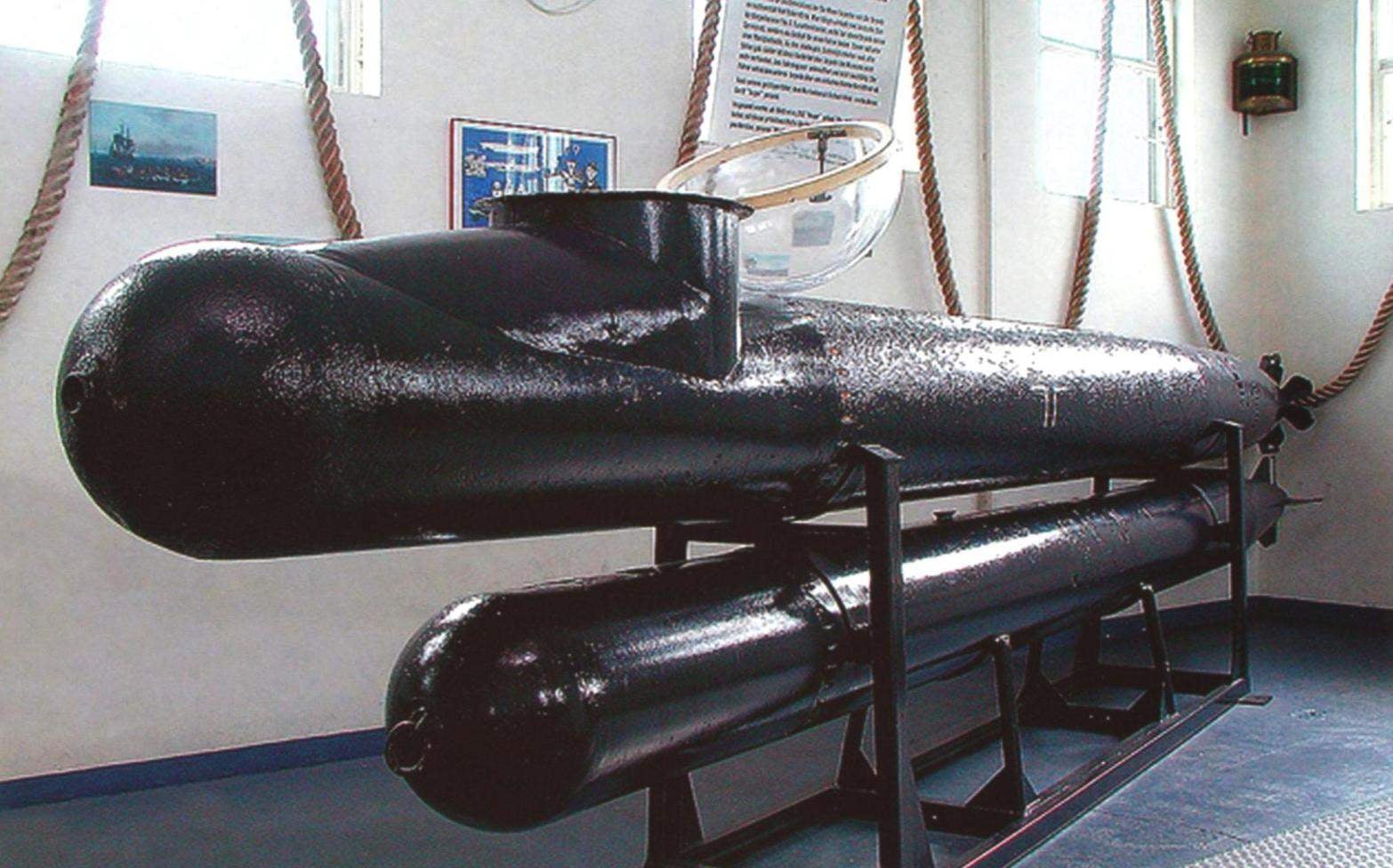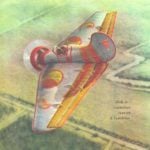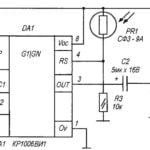 The development of guided torpedoes to sabotage units of the German fleet was conducted in parallel with the creation of the midget submarines. The first model of this weapon was designed in 1943 – 1944 chelovekovedenija torpedo “Neger”. The name came from the surname of the inventor – engineer of the fleet of Richard Mora. (“Mor” is a polite form of the German word “nigger” Neger). Moore worked at the torpedo testing station in Eckenforde in the Baltic, near Kiel. On the basis of standard torpedoes, he created a single machine that was easy to produce and used against allied ships off the coast in the event of their landing on the mainland.
The development of guided torpedoes to sabotage units of the German fleet was conducted in parallel with the creation of the midget submarines. The first model of this weapon was designed in 1943 – 1944 chelovekovedenija torpedo “Neger”. The name came from the surname of the inventor – engineer of the fleet of Richard Mora. (“Mor” is a polite form of the German word “nigger” Neger). Moore worked at the torpedo testing station in Eckenforde in the Baltic, near Kiel. On the basis of standard torpedoes, he created a single machine that was easy to produce and used against allied ships off the coast in the event of their landing on the mainland.
“Neger” was a 2 electric torpedoes G7e caliber 21″, one above the other with a gap not more than 3″. At the top of the torpedo warhead weight of 500 kg was replaced with a tiny cockpit for the pilot. It was fitted with controls: accelerator, steering wheel and the lever start the bottom of the torpedo. Simplified sight consisted of a ring on the cockpit and metal pin-fly on the nose of the torpedo.
Single-shaft motor top torpedoes could theoretically provide a “Negero” speed 20 knots. She G7e torpedo was developed 30 knots at a distance of 3.5 miles. However, to increase reserve buoyancy (to carry a torpedo lower) half of the battery was removed. As a result, the speed decreased, otherwise the distance would have been negligible. Motor top torpedoes adjusted so that the maximum speed does not exceed 10 knots.
“Neger” could not take – it was only in the positional position. Experiments with ballast tanks failed: plus the weight of compressed air for blowing tanks dangerously reduced the already small reserve buoyancy. Head and shoulders of the pilot towered over the water only 40 – 50 cm Cockpit was closed with a plexiglass dome. The relief device dome was mounted inside the cockpit, though, when the pilots opened the dome to get some fresh air, a torpedo was often overwhelmed by a wave. In its training variant to the “Neger” instead of the dome was placed a metal cabin with a rectangular window – albeit without the circular review, but more safe in the event of an accident or collision. The pilots also received oxygen devices Dreger with a mask, similar to those used by the pilots.
Volunteers in the recruitment of the pilots “negero” warned that the chances of survival does not exceed 50%. Chelovekovedenija torpedo was extremely unstable after the pilot shot combat torpedo. But even if the pilot “Neger” managed to sneak up on the enemy ship, his chance of hitting a moving target was small. German author KAUs Becker writes that Doenitz tried to limit the use chelovekonapravleny torpedoes, but the führer believed that if the Connection To will be able to “drown in the Seine estuary 6-8 battleships”, it will lead to “enormous strategic consequences.”

Mechanic helps to close the dome of the torpedo Neger. You can clearly see the pin that is welded as sight

Chelovekovedenija torpedo Hase. The pilot sat in the cockpit, and then the crane lowers the torpedo into the water
Even before the torpedoes were extensively tested, they were thrown into battle on 20 April 1944, at the fifty-fifth birthday of Hitler. About 40 “negero” 175-th To the flotilla under the command of Lieutenant Hanno Krieg was sent to the West coast of Italy, in the area South of Rome (North of the allied bridgehead of Anzio – Nettuno). The stretch of coast from which you started the “Negeri”, located in the Toppe, Paiania, about 15 miles North of Anzio. Soil the local beach was too soft to be able to lower the torpedo into the water with cranes. Torpedoes had to drag wheeled carts (each was pushing 30 soldiers) until they pop up at a sufficient depth. There were 30 trucks, 13 of them got stuck in the soft sand before she got to deep water. Thus, only 17 “negero” we were able to go Hiking. There was no moon, and the only navigation devices on torpedoes was wrist compass pilots. Some help could provide illuminating shells that were fired by the German coastal batteries, as stipulated by the plan. All 17 “negero” reached the designated area. But there, instead of standing on the anchors of the transports, they found the patrol ships.
German and American sources differ in assessing the ensuing battle. The Americans argue that the enemy was seen on April 21 at 2.30, when the RS-591 established radar contact with an invisible object. After the attack, the depth charges of the attackers were destroyed. About 7.15 American hunter RS-558 noticed a small breaker and glass dome. He performed an attack with depth bombs and pulled out of the water not the victim of the pilot “Neger”. Hunters submarines sank 2 more torpedoes. Allies say that none of the ships received no damage.
German sources say that the accident was lost 4 “Neger” and was sunk 2 small allied ships. Did officer Karl-Heinz Potthast, which entered the harbour of Anzio and ensign of Fogg in the Bay Nettuno. 5 surviving pilots sank their torpedoes and made his way back across the front line. 7 pilots withdrew their torpedoes at the Germans controlled the coast. To preserve the secrecy of the weapons, all the “Negeri” was destroyed. However, the allies captured one intact sample, which drifted near Anzio. The pilot of the torpedo died, poisoned by carbon dioxide.
“NEGERI” IN THE ENGLISH CHANNEL
In may 1944, when it became clear that the allied landing in France is imminent, the surviving veteran pilots “negero” was withdrawn from Italy. They were preparing to attack the invasion fleet. Operating losses began even before the sabotage of a flotilla made up of bases on the French coast. In the airstrike killed the commander of connection the captain of 1 rank of Krieg. However, by the end of June 1944 in the Bay of the Seine was deployed full database “negero” in Villers-sur-Mer, 20 miles from the Eastern edge of the allied bridgehead. Took command of captain 1st rank Boehme. Two companies of the construction battalion built a camouflaged track on which the truck with the “negaraku” could go down in deep water.
The night from 5 to 6 July at 23.00 for the first time the weather was favourable for the yield of torpedoes. 26 of 40 “negero” was launched at high tide to attack the transports of the allies, covered by a double line patrols ships “of the support Squadron Eastern flank”. British 890-ton minesweepers Kato (Cato) and “magic” (Magic), anchored on the Eastern edge of external sentinel ring was torpedoed and sunk. The Germans also stated that he had been hit in the destroyer and anti-aircraft landing barge LCF. The allies declared that sank only 4 chelovekonapravleny torpedoes and 5 – “probably sunk”, according to German reports did not return 12 “negero”.
Next time turned out to be quiet a clear moonless night, 21 “Neger” again went to sea. It happened on 7 July at 23.00. They attacked the ships on the line patrols, although now the enemy was on the alert, and in water at regular intervals rained down depth charges. However, the bomb patrol areas, and not Parking vehicles. A veteran of the Anzio Midshipman Potthast slipped past the escort ships came to the mouth of the Orna, where torpedoed the old light cruiser “dragon” (Dragon – ex-British ship, which operated under the Polish flag). Potthast approached to a distance of 200 metres and fired a G7e torpedo at the slow-moving ship. The explosion tore off the stern of the cruiser. “Dragon” repair did not. It was sunk as part of artificial breakwater “Gooseberry”. Triumphant Potthast left the area of battle. However, after the dawn of his “Neger” was sighted by the British trawler “Orestes” (Orestes) and fired from 20-mm machine gun. Potthast badly wounded and captured.
That same night chelovekochasov torpedo “Neger” was sunk by an 890-ton British trawler “PI-lades” (Pylades). German sources claim to have killed a British torpedo boat MTB-463 in the explosion “Neger”, which he fired, moved in close. But these successes were achieved at great cost: only 5 “negero” of the 21 returned to base. Allied ships destroyed 12 torpedoes. 4 “Neger”, drifting on the surface were destroyed on 8-9 July patrol “Spitfire”. Perhaps their pilots were suffocated.
In the night from 18 to 19 July 1944 “Negeri” made another exit in the Bay of the Seine. According to the statements of the Germans, they sank a 1370-ton British destroyer ISIS (Isis). However, a more likely cause of the explosion that killed most of the crew, looks at mine detonation. And this time the most “negero” did not return due to bad weather. The same prosolo and 15-16 August, during the last “negero” in the area Hanfler.
CHELOVEKOVEDENIJA TORPEDO “MARDER”
Chelovekovedenija torpedo “Mar-der” (“Marten”) was established on the basis of “Neger” and apparently differed only in that was longer. It is possible to establish ballast tank and the pump on compressed air. As a result, the torpedo acquired the ability for a short period to dive to a depth of 30 meters. This ability is only used to evade attacks. “Marder”, as “Neger”, operated in position position.
Initially, the Marder was planned to be used against protected anchorages. At least one ocean-going boat U-997 was equipped with a keel blocks for 4 “Mardanov”. Plans were prepared for the attack of the allied convoys to Murmansk. However, these ideas were soon abandoned. “Margery” was deployed in the English channel, replacing “Negeri”.
“MARGERY” OFF THE COAST OF NORMANDY
In the operation at Courseulles-sur-Mer, 2 – 3 August 1944 and participated not less than 50 chelovekonapravleny torpedo “Marder” and 24 exploding boat “Lens” that came out of Holgate 2 August at 23.00. The Germans hoped that the attack “Mardanov” against the line of the curtain will divert a sufficient number of escort ships. This would allow the boats to break into the center and attack the vulnerable transports.
First a warning to the allies about the appearance of “Mardanov” was the explosion of the torpedo, which is about 2.00 hit blockship – old cruiser “Durban” (Durban), flooded as part of the artificial breakwater. Less than an hour, began a fierce battle on the Northern front line patrols. Destroyers and smaller ships maneuvered at high speed, firing from automatic guns flashing dome torpedoes and dropping depth charges on the foam traces. British data suggest that the operation killed 40 “of Mardanov”. The allies also suffered losses. Escort destroyer “Quorn” (Quorn) with a displacement of 1,000 tons, was torpedoed at 2.50 and sank with heavy casualties in the crew. However, the Germans believe that it sank the boat exploding.


American soldiers looking Neger torpedo, beached near Anzio. From this picture, there are contradictory interpretations: the Germans claim that this torpedo is deceased pilot (all others were destroyed), Americans write that the torpedo was thrown out of negligence, failing to pull in deep water
Closer to the sunrise (3.50-6.00) “Margery” made a last desperate attempt to break through the line patrols. Then from under cover Mall “Gooseberry” jumped four British torpedo boats MTB. Maneuvering at speeds of 40 knots, they were shot from heavy machine guns clumsy “Margery” and in a short time sank 5 units. Another 10 expect the remaining escort ships. Escort destroyer “Blencathra” (Blencathra, 1050 tons) was damaged in the explosion of a thrown pilot “Marder”. The self-destruct mechanism is triggered just at the moment when the team tried to drag a torpedo aboard destroyer. With the dawn of Spitfires destroyed by machine gun fire from strafing 6 “Mardanov”, motionless on the surface.
The second and last massive attack defensive curtain of the allies was held on 16 – 17 Aug 42 “murderama” 363 th flotilla To come out of Holgate. The main goal of this attack was the old French battleship “Courbet” (Courbet, 23 with a displacement of 475 tons). He was standing near the shore with a raised flag of a Free France. The Germans believed that the ship combat-ready. In fact, it was also blockship, part of the Mall “Gooseberry”. Allied ships supported the illusion of the viability of the “Courbet”, conducting shelling of the shore from the seaward positions of the battleship. Old battleship got hit with two torpedoes from the “Mardanov” and the German propaganda said about the new victory of German arms. In fact, the only real success “Mardanov” was the sinking of the LCF (anti-aircraft landing barges) displacement 422 tons. During these attacks, 26 “Mardanov” was destroyed by escort ships and fighter-bombers.
The next night the ship with barrage balloons “Fratton” (Fratton, displacement, 757 tons, ex-train ferry) was sunk by a torpedo. The British decided that it has released the “Marder” (according to another version it was the acoustic mine). In this operation, “Mardanov” in the English channel ceased.
“MURDERY” ON THE MEDITERRANEAN SEA
In the late summer of 1944, after the allied landings on 15 August in the district of Marseille – Cannes (operation “Anvil -Dragoon”), the center of gravity of operations “Mardanov” moved to the Mediterranean sea. In San Remo created a Connection At the beginning of September the Germans had about 30 “of Mardanov”.
Early on the morning of 5 September 1944, five “Mardanov” came from Menton, to attack the allied destroyers, which fired at the German positions near Monte-Carlo. The German pilots had difficulties with navigation, so the attack was carried out after dawn. In 8.10, the French leader “Le Malin” (Le Malin) and USS “Ludlow” (Ludlow), awaiting orders to attack the coast near Cape Ferrat, noticed glistening in the morning sun dome “Mardanov”. “Le Malin” opened fire, forcing the nearest “Marder” dive, “Ludlow” attacked it with depth charges. 8.48 in the pilot of yet another “Marder” had left the torpedo and surrendered, when “Ludlow” rushed at him. However, following the pilot went on a suicide attack under the fire of all the guns of the destroyer. Fourth Marder were either destroyed by allied ships or died in the transition. To Menton only one returned.

Torpedo Neger prepared for transportation on trailer
A second attempt to attack the Union artillery support made 10 Sep 10 “Mardanov”, which came from Ventimiglia. It ended in the same failure.
Last exit “Margery” made from Genoa on 25 and 26 September. Again their target was the ships of artillery support. But Madison (Madison) and the French destroyer “Forbin” (Forbin) attacked and sank two chelovekonapravleny torpedoes. Recent outputs “Mardanov” in San Remo on 19 December 1944 and 1 January 1945 led to almost 100% losses in the absence of a result.
EXPERIMENTAL TORPEDOES
There were other attempts to create chelovekonapravleny the torpedo to connect the K. In 1944 – 1945 years Versuchskommando 456 designed and built a super-Marder, calling him a “hi” (Hai is German for “shark”). The torpedo shell was lengthened to 11 meters to accommodate the additional batteries. Radius increased to 63 miles, and, more importantly, on the last leg of the course of combat speed increased to 20 knots. However, the torpedo was so shaky that it was limited to building one prototype.
In July 1944, at the insistence of the commander of Connection To Vice Admiral Helmut HEYE was created Versuchung-skommando 456 (456 Experimental team). She developed the project “Dolphin”. Boat “Dolphin I” with a displacement of 2.75 tons, had a length of 5.1 meters. It was supposed to equip its petrol engine Ореl Kapitan with 80 HP, working on the closed cycle. This would allow to develop underwater speed of 30 – 40 knots. Torpedo Dolphin was equipped with a built-in warhead. For the pilot was provided the opportunity to jump out before impact with the enemy ship.
While the closed-loop motor was under development, the prototype of the “Dolphin I” was equipped with only an electric motor with a capacity of 24 HP, which allowed him to develop underwater speed of 17 knots. The idea to equip the boat shestova or towed mine, but the loss of the prototype in January 1945 marked the end of the experiments.

The performance characteristics of the German chelovekonapravleny torpedoes

L. KASHCHEEV



